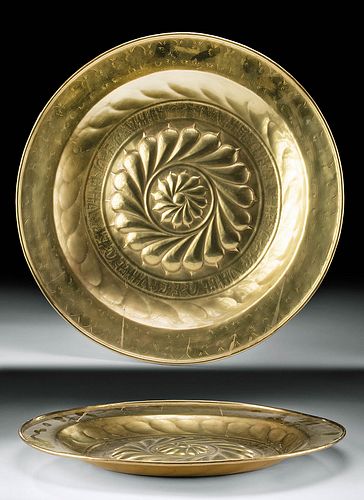16th C. German Brass Dish for Collecting Alms
Lot 174a
About Seller
Artemis Fine Arts
686 S Taylor Ave, Ste 106
Louisville, CO 80027
United States
Selling antiquities, ancient and ethnographic art online since 1993, Artemis Gallery specializes in Classical Antiquities (Egyptian, Greek, Roman, Near Eastern), Asian, Pre-Columbian, African / Tribal / Oceanographic art. Our extensive inventory includes pottery, stone, metal, wood, glass and textil...Read more
Categories
Estimate:
$900 - $1,400
Absentee vs Live bid
Two ways to bid:
- Leave a max absentee bid and the platform will bid on your behalf up to your maximum bid during the live auction.
- Bid live during the auction and your bids will be submitted real-time to the auctioneer.
Bid Increments
| Price | Bid Increment |
|---|---|
| $0 | $25 |
| $300 | $50 |
| $1,000 | $100 |
| $2,000 | $250 |
| $5,000 | $500 |
| $10,000 | $1,000 |
| $20,000 | $2,500 |
| $50,000 | $5,000 |
| $100,000 | $10,000 |
| $200,000 | $20,000 |
About Auction
By Artemis Fine Arts
Jan 21, 2021
Set Reminder
2021-01-21 10:00:00
2021-01-21 10:00:00
America/New_York
Bidsquare
Bidsquare : Ancient / Ethnographic From Around The World
https://www.bidsquare.com/auctions/artemis-gallery/ancient-ethnographic-from-around-the-world-6316
Ancient art from Egypt, Greece, Italy and the Near East, as well as Asian, Pre-Columbian, Native American, African / Tribal / Oceanic, Spanish Colonial, Russian Icons, Fine art, much more! All categories, all price ranges... all legally acquired and guaranteed to be as described or your money back. Artemis Fine Arts info@artemisfinearts.com
Ancient art from Egypt, Greece, Italy and the Near East, as well as Asian, Pre-Columbian, Native American, African / Tribal / Oceanic, Spanish Colonial, Russian Icons, Fine art, much more! All categories, all price ranges... all legally acquired and guaranteed to be as described or your money back. Artemis Fine Arts info@artemisfinearts.com
- Lot Description
Western/Central Europe, probably Germany or Belgium, ca. 16th century CE. A sizable and highly polished hammered brass alms plate from a church. The raised central basin bears 18 bulbous flower petals surrounding a narrower central flower, and enclosing the foliate motif is a raised inscription consisting of six repeating Gothic letters. The curved basin walls exhibit additional flower petals impressed across the surfaces, and the wide rim displays stamped semicircular rungs above two faint registers of radiant stars and a rolled lip. Size: 17" Diameter x 1.6" H (43.2 cm x 4.1 cm)
In the early 16th century, brass alms dishes had become very wide in diameter, with a wide base and ample room for designs. Abstract central motifs like this one were often surrounded by lettering, but the inscriptions were usually meaningless - just design elements. Many of these plates were produced in Nuremberg, with others produced in Flanders, Bouvignes, and Aachen, but they all shared techniques, making them difficult to assign to a single area of manufacture. When Charles the Bold took the city of Divant in Flanders in 1466, metalworkers fled from there to neighboring areas, spreading this technology and artistic style. These dishes were not just used for alms - or even, depending on location, primarily. Exported to the British Isles, they found their way to churches there as alms plates, but on continental Europe, paintings often show them used as basins for washing hands after a meal. Prior to forks being commonly used in the 17th century, this was a necessary part of the table.
Provenance: private San Francisco, California, USA collection
All items legal to buy/sell under U.S. Statute covering cultural patrimony Code 2600, CHAPTER 14, and are guaranteed to be as described or your money back.
A Certificate of Authenticity will accompany all winning bids.
We ship worldwide and handle all shipping in-house for your convenience.
#137911Very slight bending to overall form, with softening to some Gothic letters and stamped motifs on rim, and light abrasions, otherwise intact and excellent. Great patina and nice preservation to decorations.Condition
- Shipping Info
-
All shipping is handled in-house for your convenience. Your invoice from Artemis Gallery will include shipping calculation instructions. If in doubt, please inquire BEFORE bidding for estimated shipping costs for individual items.
-
- Buyer's Premium



 EUR
EUR CAD
CAD AUD
AUD GBP
GBP MXN
MXN HKD
HKD CNY
CNY MYR
MYR SEK
SEK SGD
SGD CHF
CHF THB
THB
















